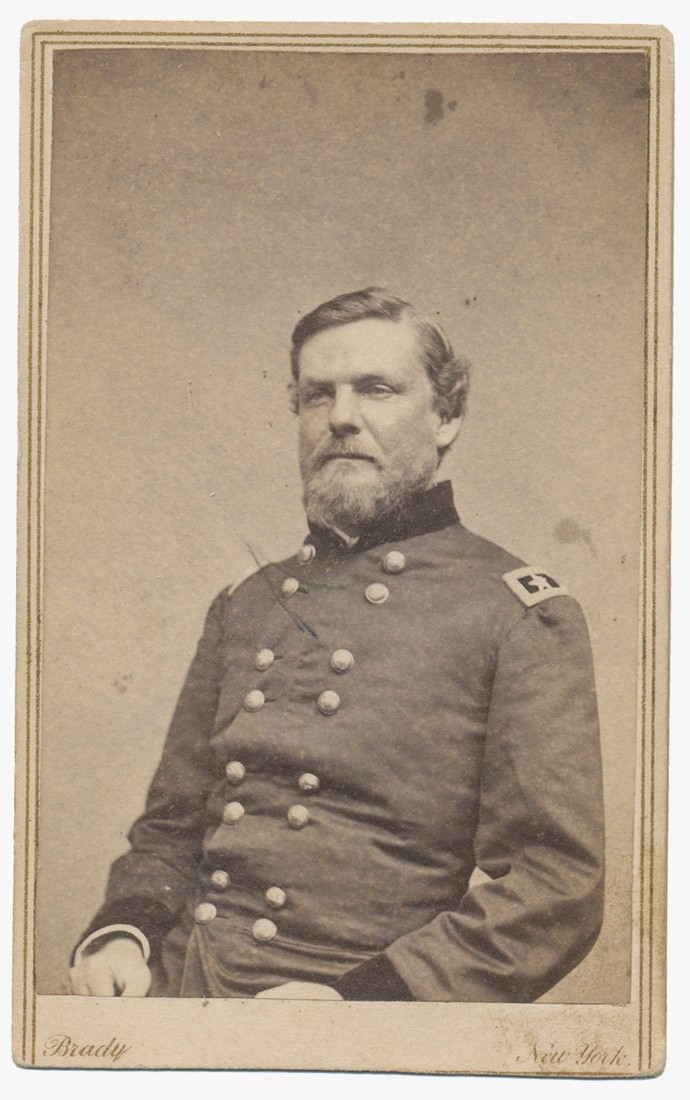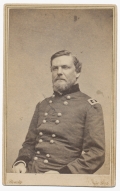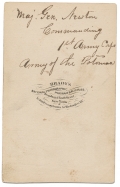site search
online catalog
WAIST-UP VIEW OF GENERAL JOHN NEWTON BY BRADY WITH INK INSCRIPTION

$200.00 SOLD
Quantity Available: None
Item Code: 1094-139
Nice waist up CDV of General Newton in a dark double-breasted frock coat with a black felt collar and cuffs with major general’s shoulder straps.
Image is clear with excellent contrast. Mount and paper are good with light edge dirt. The bottom of mount is marked BRADY – NEW YORK.
Reverse has photographer’s imprint for BRADY’S NATIONAL PHOTOGRAPHIC GALLERIES. Top has a nice bold period ink inscription of “MAJ. GEN. NEWTON, COMMANDING 1ST ARMY CORPS ARMY OF THE POTOMAC.”
Newton was born in 1823 in Norfolk, Virginia, a city his father represented in the U.S. Congress for 31 years. He ranked second in the United States Military Academy class of 1842 and was commissioned in the Corps of Engineers. He taught engineering at the Military Academy (1843–46) and constructed fortifications along the Atlantic coast and Great Lakes (1846–52). He was a member of a special Gulf Coast defense board (1856) and Chief Engineer, Utah Expedition (1858).
Newton stood firm for the Union and helped construct the Washington defenses and led a brigade in the Peninsula Campaign. In the Maryland Campaign, at South Mountain, he led a bayonet charge that resulted in taking the enemy position, and also fought at the Battle of Antietam.
As a division commander in the VI Corps, he participated in the Battle of Fredericksburg. After that disastrous defeat, he and other generals journeyed to see President Lincoln and informed him of their lack of confidence in their commander, Maj. Gen. Ambrose E. Burnside. This was one of the causes of Burnside's relief in January 1863, but it also damaged Newton's career. He was promoted to major general on March 30, 1863 but Congress never officially confirmed it and the promotion expired a year later.
In the Chancellorsville Campaign, Newton was wounded at Salem Church. At Gettysburg, George Meade named Newton to command of the I Corps after John F. Reynolds was killed in the battle. Newton commanded the I Corps until the start of the Overland Campaign in the spring of 1864, when the I Corps was dissolved and its remnants divided among the II and V Corps. At this point, Newton reverted to the rank of brigadier general and was sent west to serve with William T. Sherman.
In the Atlanta Campaign, he commanded the 2nd Division, IV Corps, in Maj. Gen. George H. Thomas's command. He served under Sherman, who regarded him highly. At the Battle of Peachtree Creek, he prevented a dangerous Confederate movement against Sherman and his rapidly constructed works allowed him to turn back the Confederate thrust, a victory that put his official military career back on track.
After the capture of Atlanta, Newton left active field duty and commanded the District of Key West and the Tortugas of the Department of the Gulf from 1864 to 1866. His last campaign resulted in a defeat at the Battle of Natural Bridge in Florida in March 1865, which temporarily enabled the Confederates to hold on to the state capital.
Returning to the Corps of Engineers after the war, Newton oversaw improvements to the waterways around New York City. He also had charge of New York Harbor defenses until he was appointed Chief of Engineers in 1884. Newton retired from the Army in 1886 and served as Commissioner of Public Works, New York City (1886–88), and as President of the Panama Railroad Company (1888–95). He died in New York City on May 1, 1895 of complications from heart disease and rheumatism, and is buried at West Point. [AD]
~~~~~~~~~~~~~~~~~~~~~~~~~~~~~~~~~
THIS ITEM, AS WITH ALL OTHER ITEMS AVAILABLE ON OUR WEB SITE,
MAY BE PURCHASED THROUGH OUR LAYAWAY PROGRAM.
FOR OUR POLICIES AND TERMS,
CLICK ON ‘CONTACT US’ AT THE TOP OF ANY PAGE ON THE SITE,
THEN ON ‘LAYAWAY POLICY’.
THANK YOU!
Inquire About WAIST-UP VIEW OF GENERAL JOHN NEWTON BY BRADY WITH INK INSCRIPTION
For inquiries, please email us at [email protected]
Most Popular
Historical Firearms Stolen From The National Civil War Museum In Harrisburg, Pa »
Theft From Gravesite Of Gen. John Reynolds »
Cavalry Carbine Sling Swivel »
Fine Condition Brass Infantry Bugle Insignia »
featured item
HALF-PLATE DAGUERREOTYPE OF C.S. MAJOR GENERAL STEPHEN DODSON RAMSEUR AND C.S. COLONEL FRANK KINCLOCH HUGER AS WEST POINT CADETS BY JAMES EARLE McCLEES, PHILADELPHIA
This important half-plate daguerreotype comes from the collection of the late Bill Turner and shows future Confederate Major General Stephen Ramseur on the left and future Confederate artillery Colonel Frank Huger, son of CS General Benjamin Huger on… (1138-1780). Learn More »




